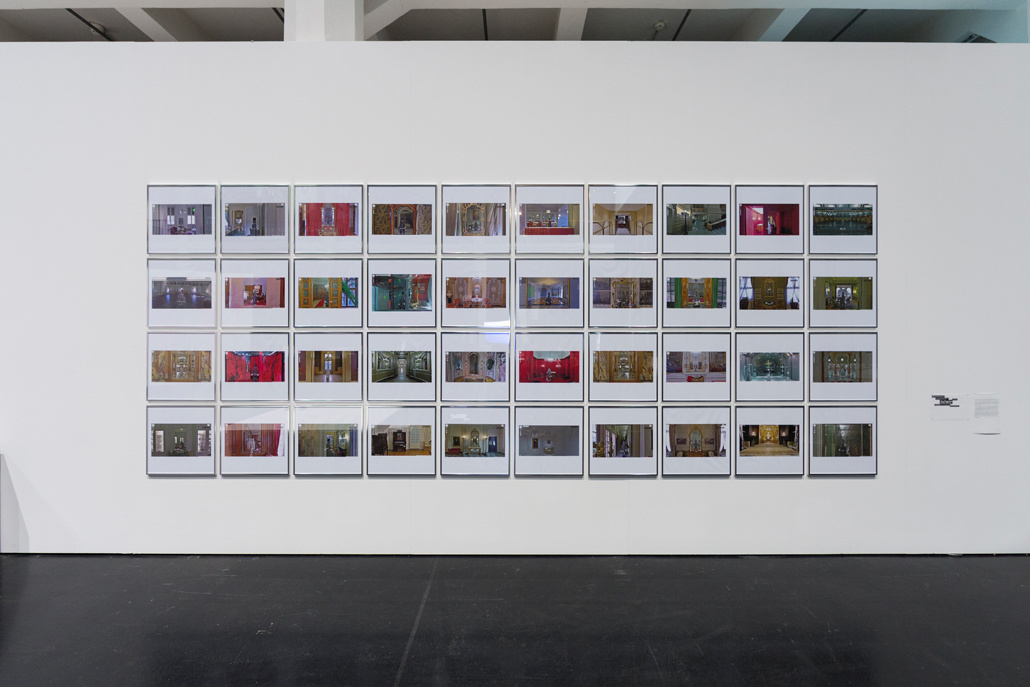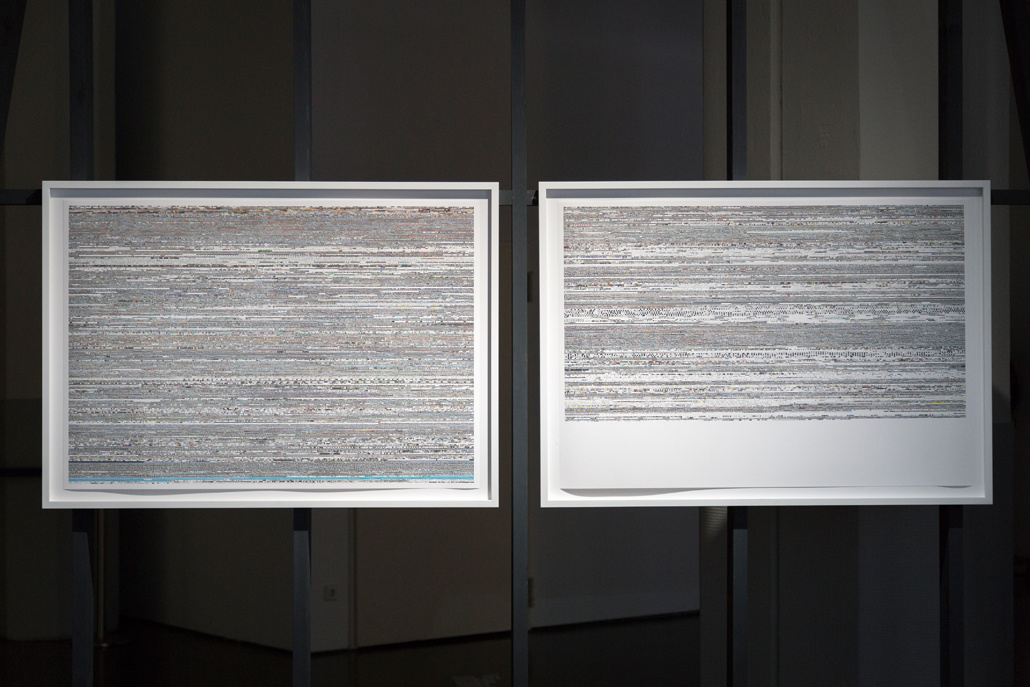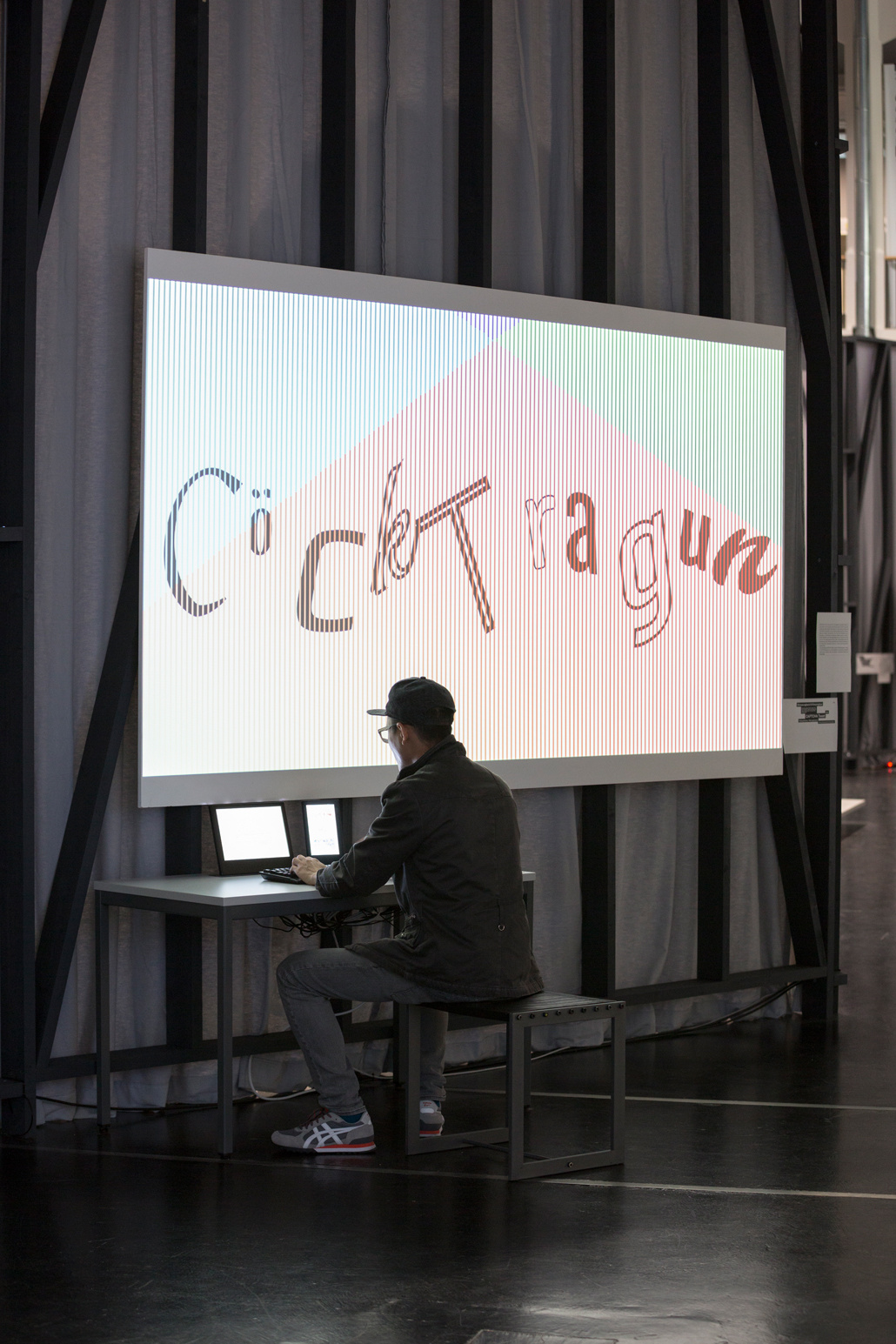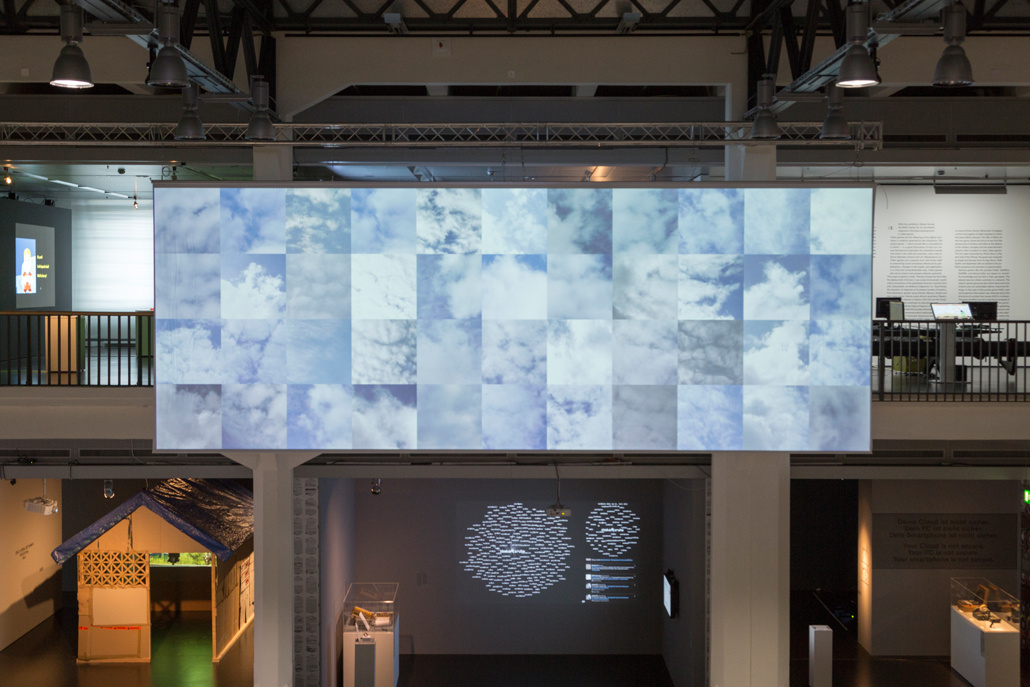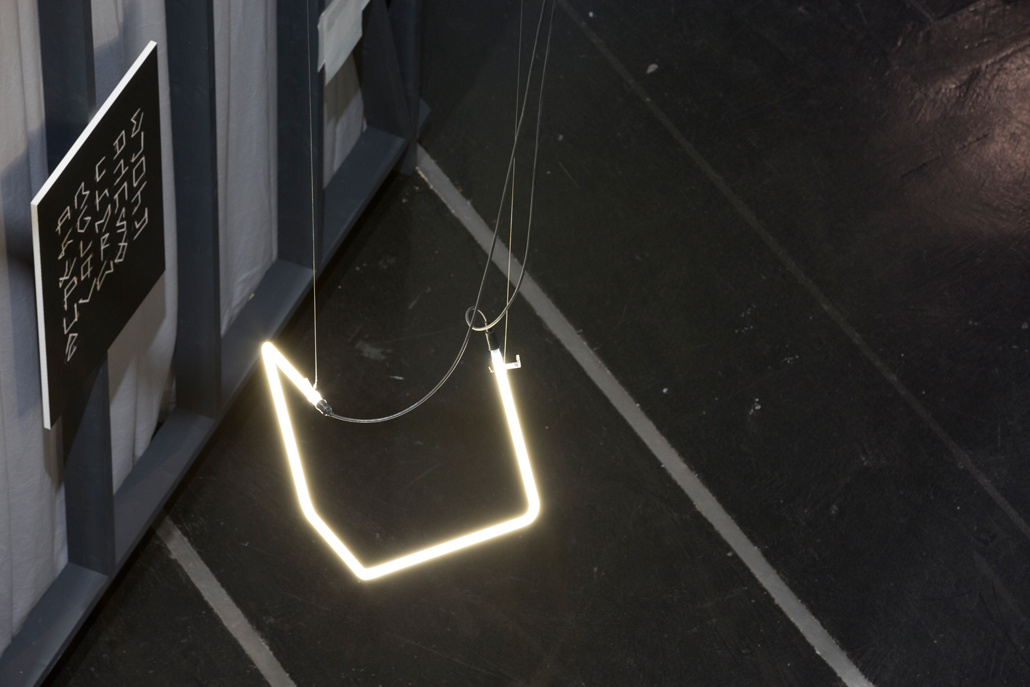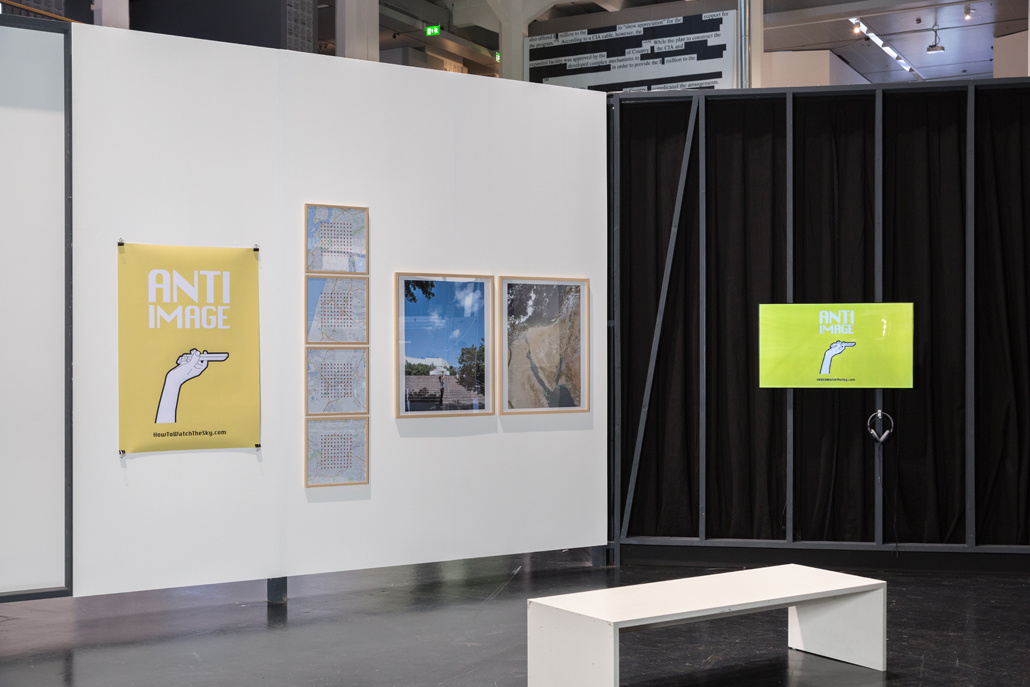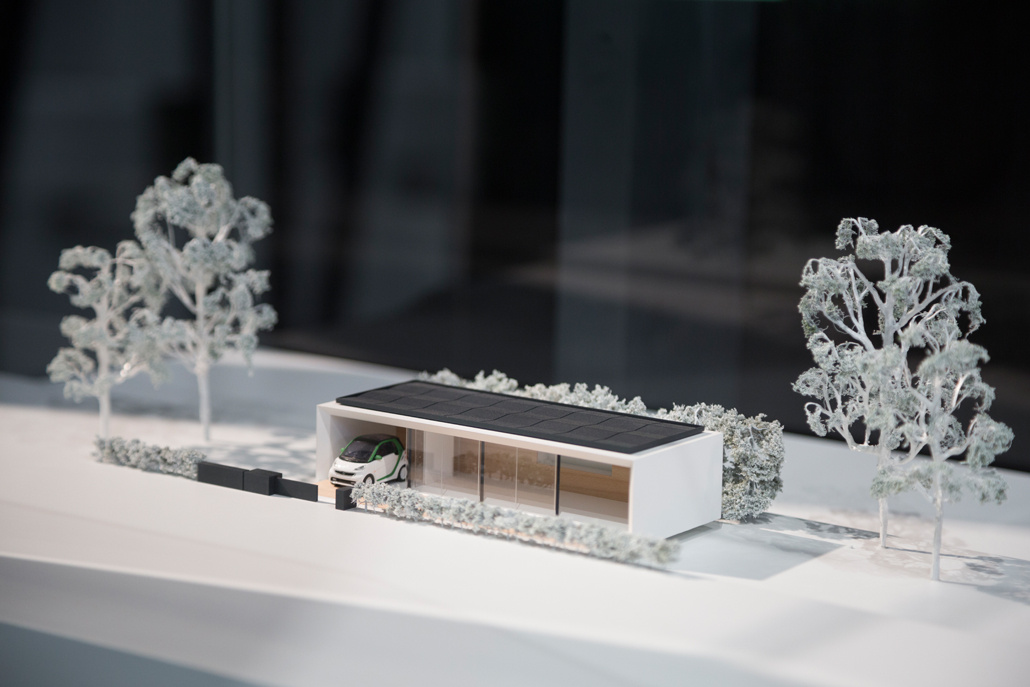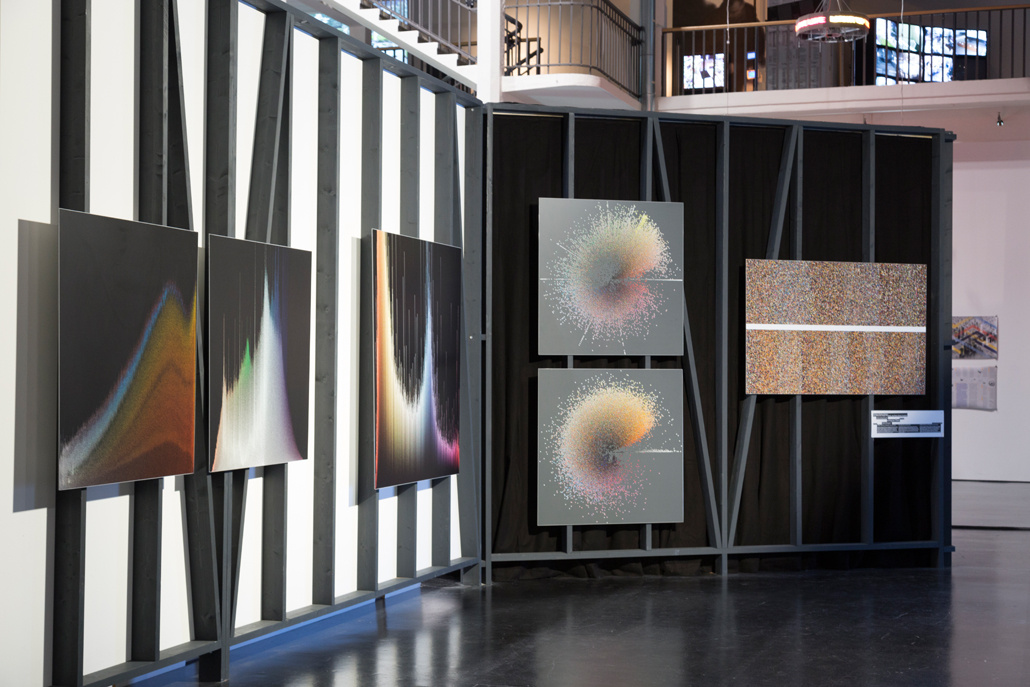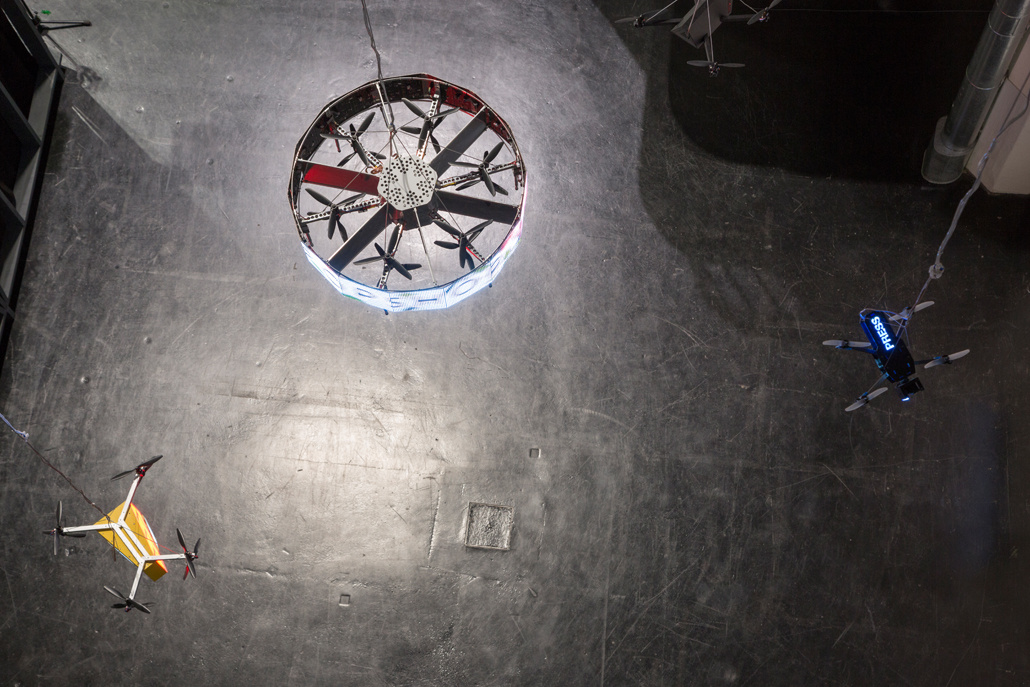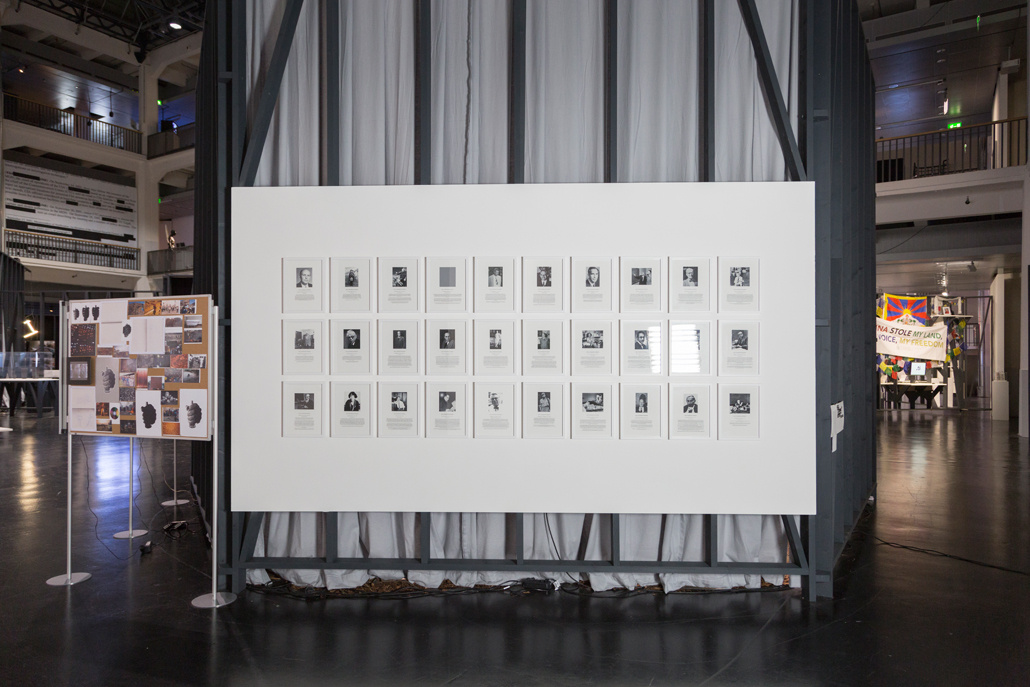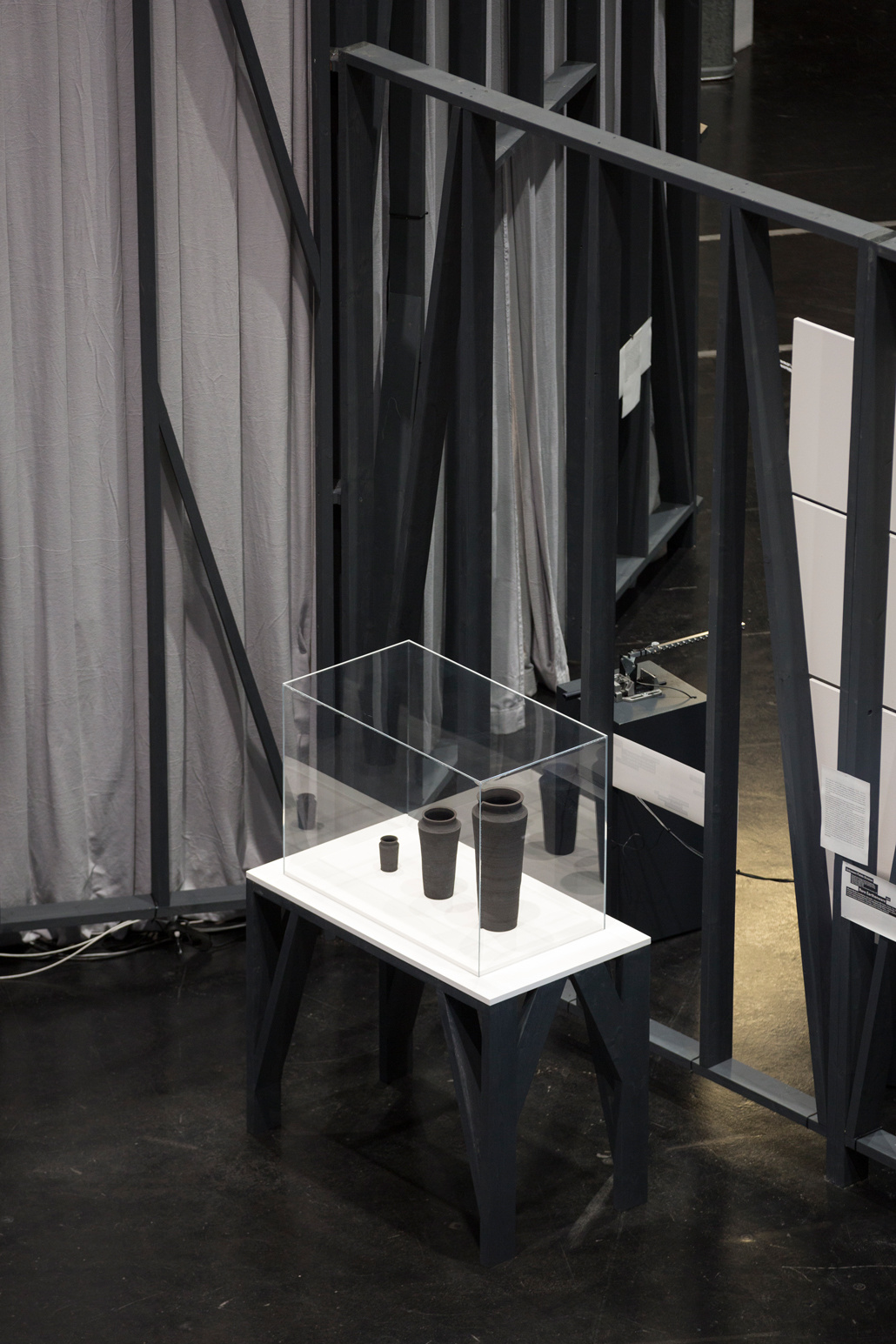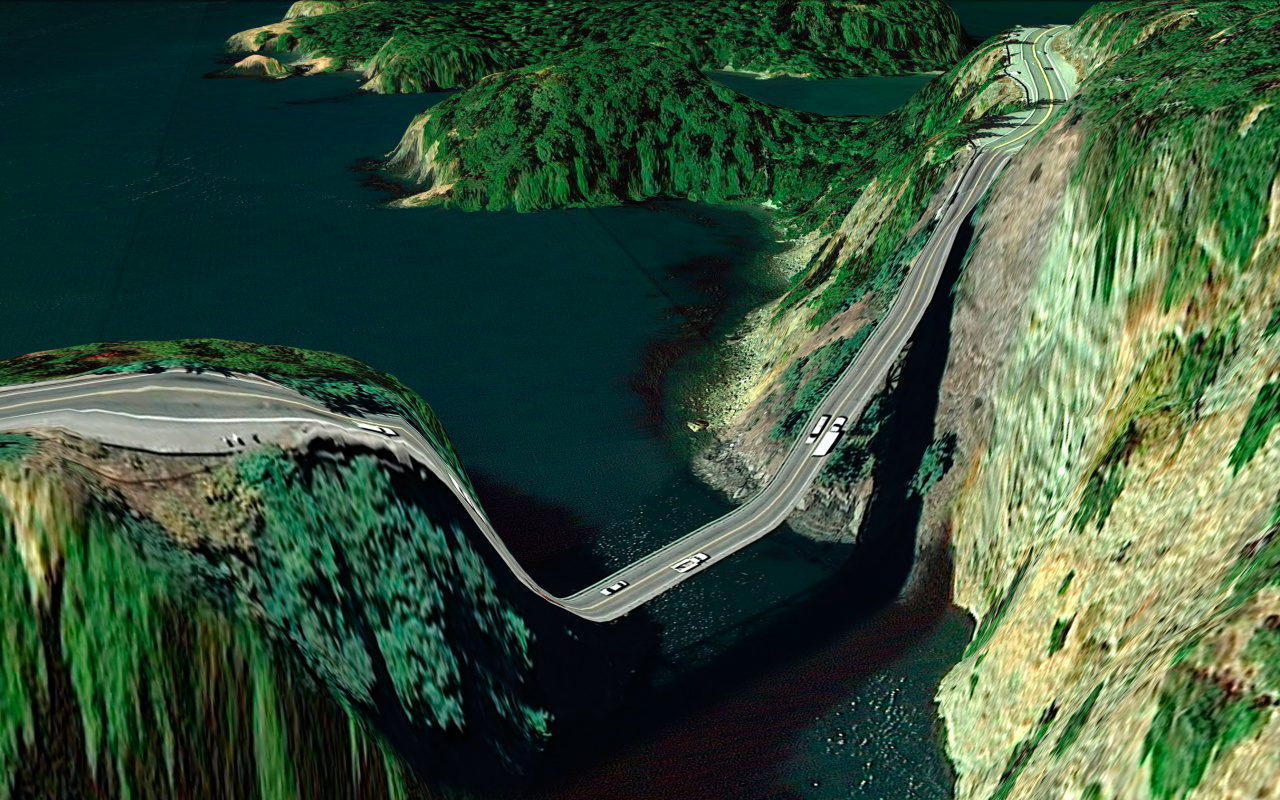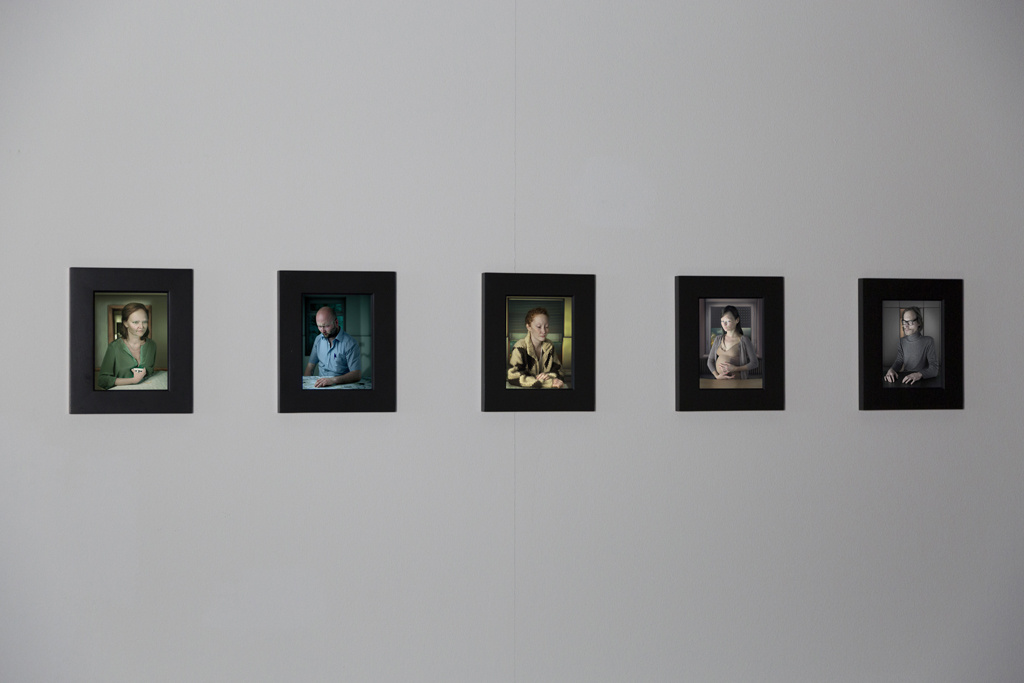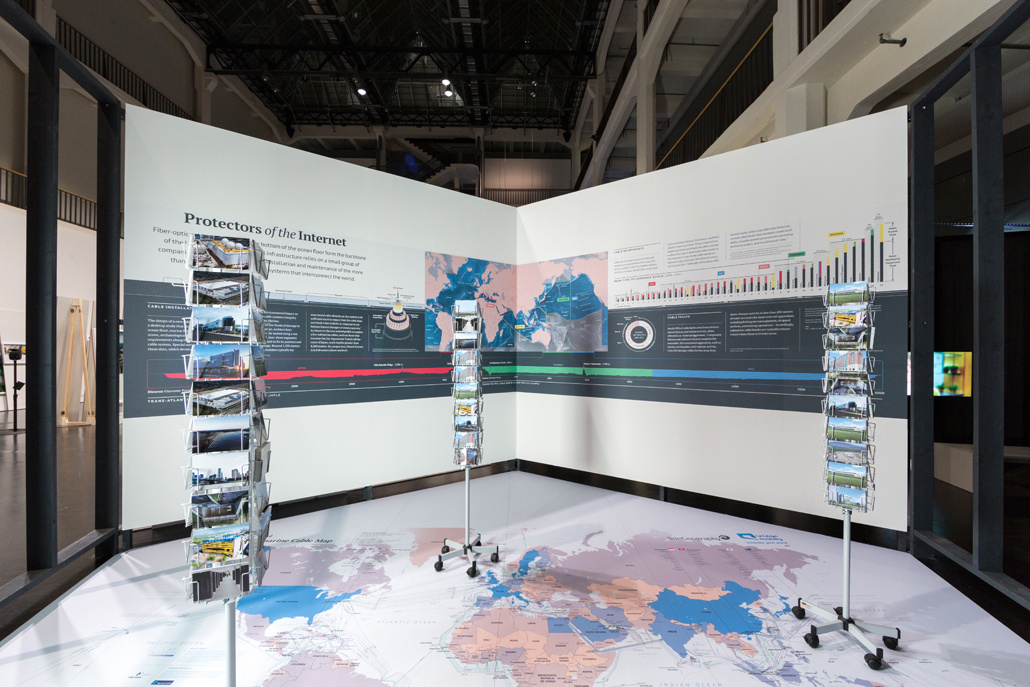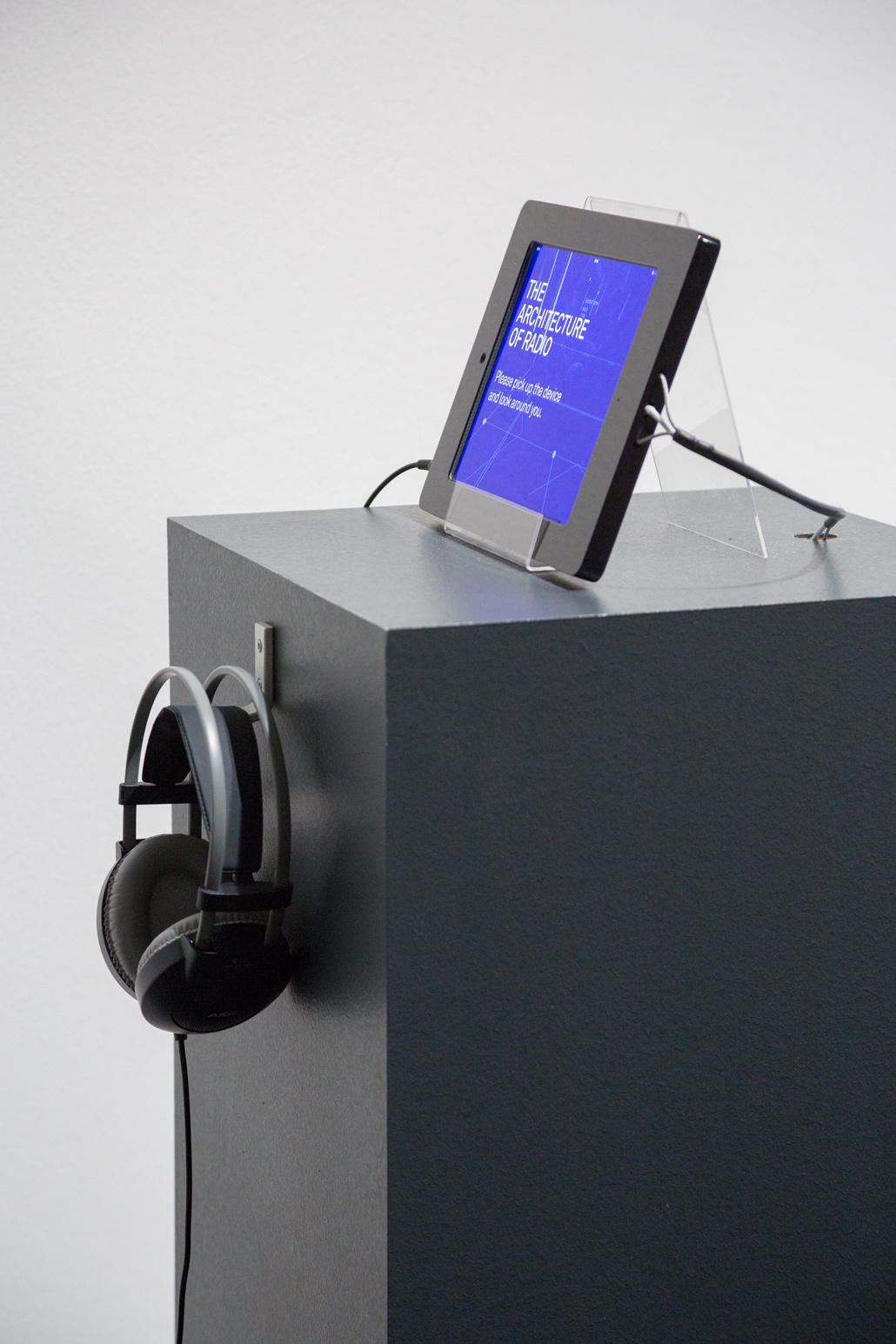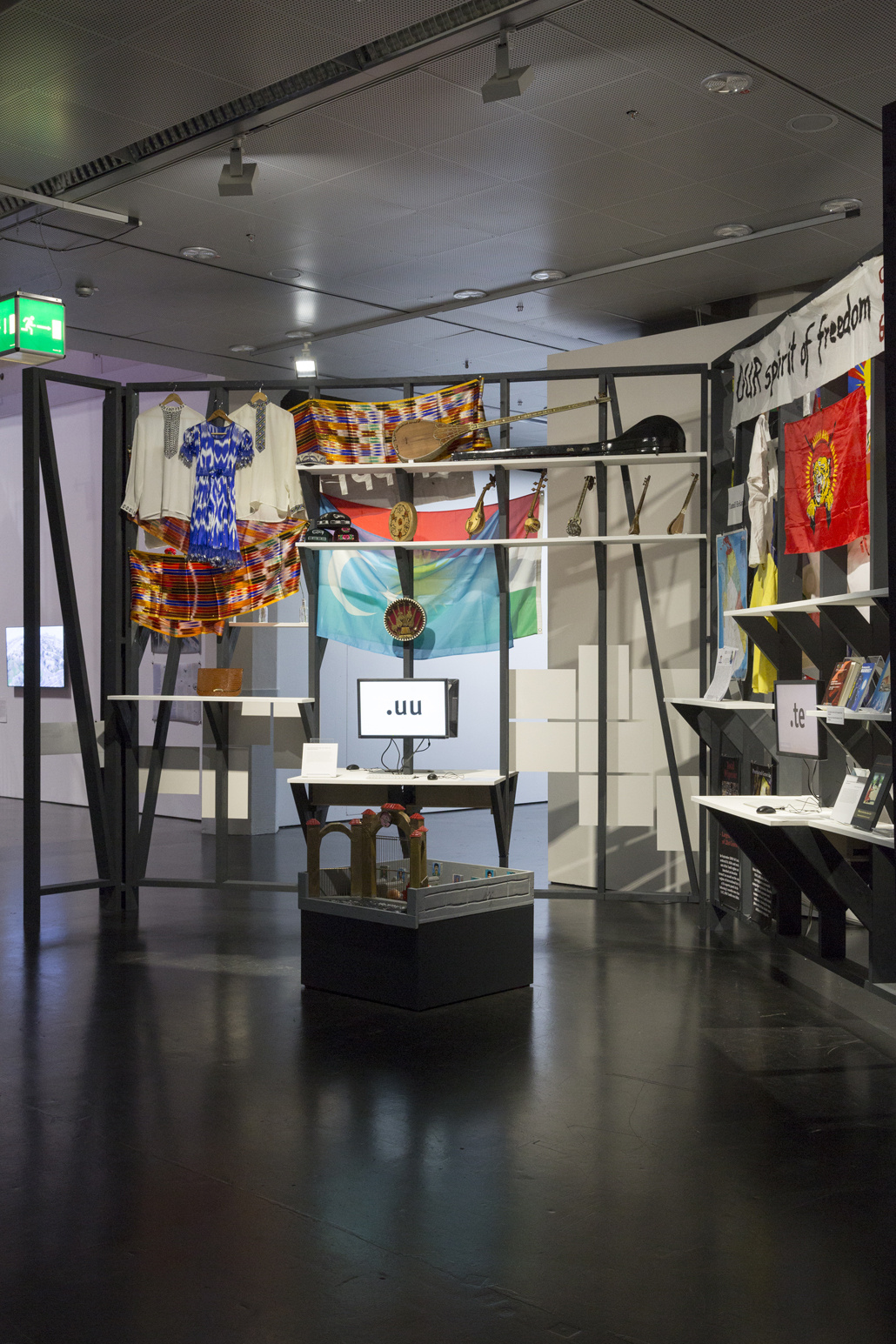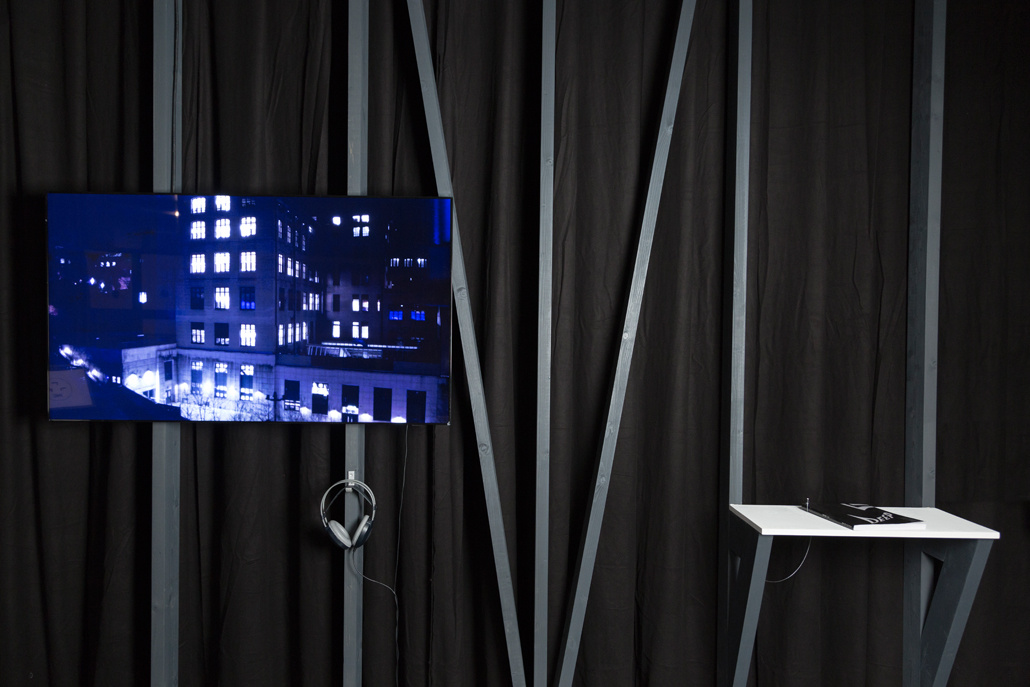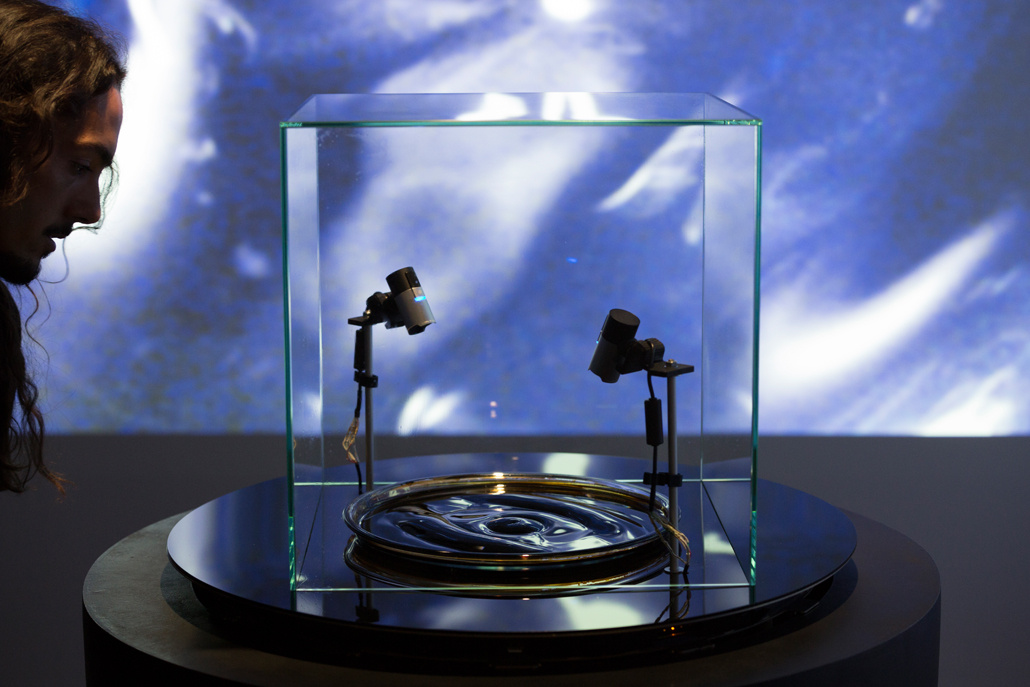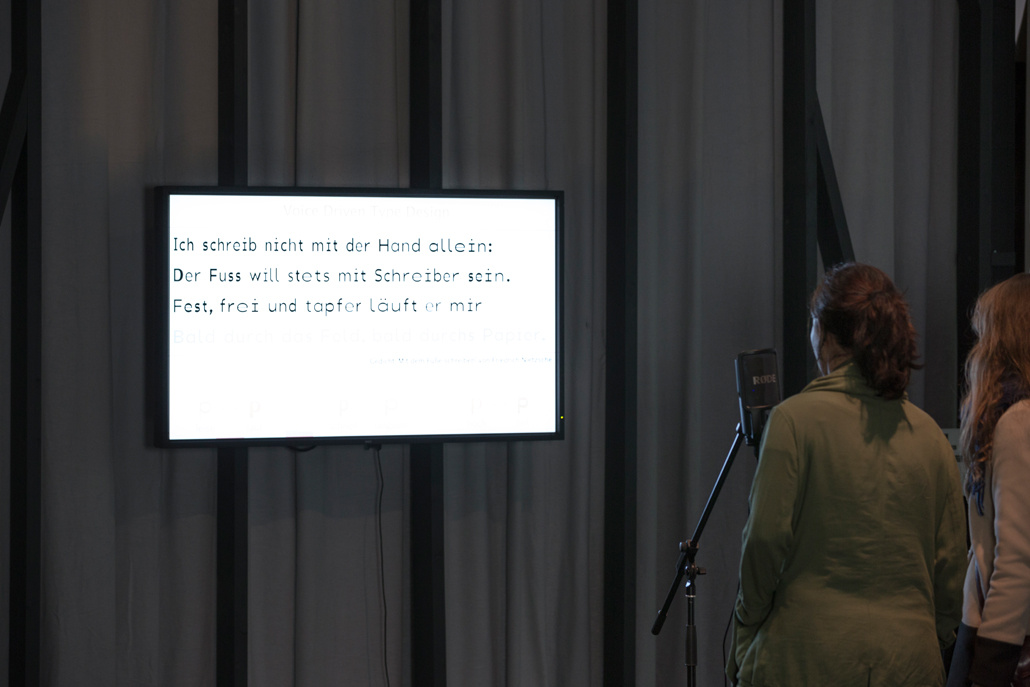Works of the Aritsts S–Z
Infosphere
| S Mario Santamaría: »The Phantom of a Mirror« Philipp Schaerer: »Diary« Semiconductor: »20 Hz« & »Magnetic Movie« Shinseungback Kimyonghun: »CAPTCHA Tweet« & »Cloud Face – Real Time« Adam Słowik: »ABC Object« Smart Citizen Team: »Smart Citizen Project« Karolina Sobecka und Christopher Baker: »Picture Sky« Werner Sobek: »Aktivhaus B10. Stuttgart/Deutschland« Software Studies Initiative: »Instagram Cities« Superflux: »Drone Aviary« | T Timo Toots: »Media Bubble« Suzanne Treister: »HEXEN 2.0« |
| U Unknown Fields Division: »Rare Earthenware« | V Clement Valla: »Postcards from Google Earth« Alex Verhaest: »The Dinner Scene« José Luis de Vicente: »From the Secret to the Monument« Richard Vijgen: »Architecture of Radio« |
| W Christoph Wachter & Mathias Jud: »New Nations« Addie Wagenknecht: »Deep Lab« Gwenola Wagon: »Globodrome« Peter Weibel, Bernd Lintermann, Torsten Belschner, Mahsa Jenabi, Werner A. König: »CloudBrowsing – Wiener Kreis« Where Dogs Run: »FIELDS 2.1« Krissy Wilson: »The Art of Google Books« Matthias Wölfel: »Voice Driven Type Design« & »Responsive Type« Manfred Wolf-Plottegg: »CONTENT GENERATOR« | |
_____________________________________________________________
Mario Santamaría
The Phantom of the Mirror (2013–2015)
In an ambitious museum project, Google has been digitizing all works of art in museum holdings and the interiors of museums, collections and architectural monuments since 2011. In order to enable a virtual tour through these places worldwide, a Google photo robot photographs the respective rooms completely as 360° shots. The screen captures by Spanish artist Mario Santamaría put together those photographs in which the photo robot itself is reflected in the art objects or in a wall mirror. While Google strives not to show the cameras and thus to appear as objective, documentary and neutral as possible, Santamaría places the act of photography in the foreground. The cameras' unintentional self-portraits draw attention to the hardware behind the online service and show a camera standing completely alone in deserted rooms surrounded by art and objects from past centuries. »The Phantom of the Mirror« is part of the series »Trolling Google Art Project«.
_____________________________________________________________
Philipp Schaerer
Diary (2005 – ongoing)
Not only do we carry our work around with us on our notebooks, we also constantly record our private life on our hard drives – the computer has become a kind of diary that records a part of our being continuously and reliably. Consciously or unconsciously, we document ourselves continuously, and this in a crowd that is becoming increasingly confusing and can increasingly only be opened up fragmentarily and selectively. Since 1998 Philipp Schaerer collects all important or interesting documents (photographs, graphics, plans, diagrams, text and layout documents) in digital form. Since 2005 he has also been importing them into a media database, naming them according to a seemingly conclusive system and providing them with keywords. By June 2015, for example, it had accumulated over 135,700 data records. None of this takes up any physical space; search masks can be used to quickly and easily penetrate the digital data world. But on the computer you can only see subsets that have been detached from their context, the feeling for quantity is lost. The work Diary proposes a different approach to the accumulated data material and tries to make the entire amount of data tangible as an image by means of optical perception. The data records made visible as image miniatures are arranged chronologically according to date of entry on the respective rows and thus follow the logic of the classic diary.
_____________________________________________________________
Semiconductor
20 Hz (2011)
Like a plate covered with the finest iron filings and exposed to electromagnetic waves, the field, apparently extending in front of the camera, vibrates and pulsates. From the almost total darkness, the fluttering particles glow as if illuminated by horizontal rays that reveal their surface structure and by vertical rays that counterpoint the circular and linear movements of the material through their own light patterns. But this complex spectacle is not only visible, but above all audible: a background noise, a crackling, high chirping noises and punctual rumbling accompany both the moving material and the flickering light. In reality, this work is a digital animation in which Semiconductor uses its own software to give the sonified measured data from the Earth's magnetosphere a visible, sculptural form. The title »20 Hz« refers to the frequency range to which the signals captured by the magnetometer are counted down, otherwise the recorded sounds cannot be heard by the human ear.
_____________________________________________________________
Semiconductor
Magnetic Movie (2007)
In »Magnetic Movie« you dive into the atmosphere in a scientific laboratory on the border between science and fiction: Coloured flickering fields miraculously emerge from the laboratory's equipment, sibilantly spreading and disappearing again. The voice-over consists of interviews with scientists who led semiconductors during their research stay at NASA's Space Sciences Laboratory at UC Berkeley. For the artists, the decisive question was how to describe natural phenomena in words and at the same time develop a visual language for them. The film consists of photographs taken in the laboratory, which were brought to life by camera work and computer-generated animation. The animation is based on current scientific descriptions of the magnetic fields of planets recorded by satellites. The artists imitated the form and movement of these visualizations to create a representation of this scientific language.
_____________________________________________________________
Shinseungback Kimyonghun
CAPTCHA Tweet (2014)
CAPTCHA is an acronym for »Completely Automated Public Turing Test to Tell Computers and Humans Apart«, named after the British mathematician Alan Turing. A computer can use a CAPTCHA to determine whether its communication partner is a human being or another computer. The test is designed to be simple for humans, but cannot be removed from computers, supercomputers and artificial intelligence according to the current state of the art or not in a reasonable time. For example, the users of a website are asked to enter a character combination in an empty field, which is previously displayed in a distorted image. The CAPTCHA Tweet application converts Twitter messages, Tweets, into CAPTCHA characters and thus enables digital »cryptographic« communication that cannot be read by computers.
_____________________________________________________________
Shinseungback Kimyonghun
Cloud Face – Real Time (2015)
Pareidolia is the illusion of recognizing in things and patterns supposedly familiar beings or objects. Such a phenomenon can be observed in the perception of cloud images. For example, the human brain understands certain cloud forms as human faces. The installation »Cloud Face – Real Time« presents a collection of cloud images in which not humans, but facial recognition software capture human faces in cloud images. The images portrayed are the result of a complex facial recognition algorithm. With this work, the artists investigate the relationship between computer vision and human vision.
_____________________________________________________________
Adam Słowik
ABC Object (2011)
The »ABC Object« initially appears irritatingly meaningless in its form. The simple looking but fourfold curved neon tube can be read from different perspectives. If one looks at the luminous body contrary to everyday viewing habits – in a two-dimensional way – all 26 letters of the alphabet are displayed in the single-acting tube.
_____________________________________________________________
Smart Citizen Team association with IAAC | Fab Lab Barcelona, Media Interactive Design and Hangar
Smart Citizen Project (2012 – ongoing)
The inability to actively intervene in data collection processes and to participate in the analysis of the data collected represents one of the greatest challenges posed by the current changes in our environment. The Smart Citizen Project conceives a platform as a possible solution to strengthen the participation and cooperation of people in their cities. The project promotes the development of a global network of sensors, so-called »Smart Citizen Kits«, which pass on local environmental conditions to the online platform https://smartcitizen.me. The kit is able to measure temperature, humidity, air quality (such as carbon monoxide and nitrogen dioxide content) and light conditions at its location. The data collected and visualized on the platform sensitize for the perception of the finest environmental changes and thus enable a more efficient and for everyone accessible analysis of the connections between resources, technologies, communities and services in an urban environment.
_____________________________________________________________
Karolina Sobecka und Christopher Baker
Picture Sky (2015)
Satellite images of the earth are firmly integrated into our everyday life, they are used for navigation, surveillance or military reconnaissance. Man has made the bird's eye view his own and is equally determined by it. Sobecka and Baker's »Picture Sky« project takes the opposite direction: With an app, she assembles photos of the sky taken by a group of people along a previously calculated grid using their smartphones. The photos are taken exactly at the moment when a satellite captures the corresponding area from above. This provides the exact counter image to the satellite image. This counter-image, which is created with the participation of many individuals, supplements the technical picture with human judgement and integrates man into the technological process. The participatory character of the project also emphasises the importance of the social in the implementation of technological innovations.
_____________________________________________________________
Werner Sobek
Aktivhaus B10 Stuttgart/Deutschland (2013–2014)
In 1927, the so-called »Weißenhofsiedlung« was built in Stuttgart, commissioned by the »Deutscher Werkbund«. The architects who built here experimented with new materials and forms and tested how to build and live in the future. Since 2014, Werner Sobek's active house, known as »B10« for short, has been standing on a plot of land that has not been developed for a long time – Bruckmannweg 10. The house is a research object that illustrates how innovative materials, constructions and technologies can sustainably improve our built environment. The term »active house« refers to a building that generates more energy than it needs on its own or in combination with other houses. Thanks to a sophisticated energy concept and self-learning building control system, the »Active House B10« achieves twice its own requirements. The surplus is used to power two electric cars and the listed house of architect Le Corbusier. Following the research project, »B10« will be completely dismantled and completely recycled. During the entire project period, in addition to parameters for evaluating energy consumption and generation, a large amount of other data is collected and scientifically evaluated.
_____________________________________________________________
Software Studies Initiative (Lev Manovich, Nadav Hochman, Jay Chow, Damon Crockett)
Instagram Cities (2013–2015)
The graphics »Instagram Cities« emerge from the project »Phototrails«, in which data from the social media platform Instagram are processed with the aim of gaining social, cultural and political knowledge about their users. Thus, 2.3 million images from thirteen metropolises worldwide were downloaded and evaluated. For the creation of the information graphics, not only the metadata of the images, such as the shooting date, but also visual properties such as hue and contrast were made usable. These characteristics are used to draw conclusions about the cultural life of individual cities, for example, in which metropolises are often photographed at night. Also time-specific characteristics and local events were investigated, e.g. whether the upload frequency changed noticeably during one of three Israeli Memorial Days. Finally, the multiscale-principle should not only show a picture of whole social groups, but also reveal the behaviour of individuals. The »visual routine« of the top users from Tel Aviv – for example the location and time of uploads – was illustrated using individual net-like diagrams.
_____________________________________________________________
Superflux
Drone Aviary (2015)
With Drone Aviary, Superflux explores the potential possibilities of a reality in which drones perform a wide range of functions and are part of an urban ecosystem. The artists introduce themselves to a family of five civilian drones, each designed and programmed for different functions, in this case advertising, surveillance, traffic, journalism and social media communication. Superflux explore drones in their social, political and cultural dimensions, discussing whether they could also be democratic tools. The drones hang in the exhibition space as models of a possible future, but are also shown in a video in which one sees a »smart city« of the near future as it is perceived and »scanned« by the drones. Beyond their simple control framework, these intelligent machines also perform complex tasks and are part of human reality and our daily lives and influence both. As already at the beginning of the film in a quote from McKenzie Warks essay »Globalization from Below: Migration, Sovereignty, Communication« means: »We no longer have roots, we have antennas [...]. We no longer have origins, we have terminals.« This creates a future scenario in which emerging technologies – from drones to wearables and driverless vehicles – share the same spaces with people in order to become more and more present and to shape the city with new physical and digital infrastructures.
_____________________________________________________________
Timo Toots
Media Bubble (2008)
A small circular wooden disc on the floor of the exhibition space invites visitors to stand individually on it. As soon as a person enters the platform, it begins to jerk to the left or right. Immediately afterwards, headlines from local news circle the platform as floor projections, rapidly multiplying and overlapping. A loud voice recites the headlines. For each new headline, the same machine-made male voice is raised anew, so that finally a garish, overwhelming cacophony from the latest news fills the exhibition space. As soon as a visitor leaves the platform, the flow of messages slows down until the voices and lines of text last expire. The installation »Media Bubble« blends in with the specifics of the respective exhibition location by receiving local, regional and national news for the headlines via the Internet. Moreover, the work places media consumers at the centre of news production – »without you there is no media bubble«.
_____________________________________________________________
Suzanne Treister
HEXEN 2.0 / Macy Conference Attendees (2009–2011)
In his book »From Counterculture to Cyberculture« (2006), media scholar Fred Turner traces a cultural development that ranges from the birth of cybernetics in the 1940s to the hippie movement of the 1960s and the neoliberal cyberculture of the 1990s. The work »HEXEN 2.0« by Suzanne Treister seems to span a similar historical arc. The installation, which consists of photographic works, graphics and a video, thematizes the so-called Macy Conferences that took place in the USA between 1946 and 1953. Renowned scientists from various disciplines met there to work out the basics of cybernetics and thus techniques for controlling the human psyche and society. Treister's narrative about these institutional aspirations, which should serve to intensify the control of society, is supported by an esoteric formal language that refers to counterculture by means of »alchemical diagrams« and numerology as well as recourse to spiritualism and witchcraft. With the reference to Web 2.0 in the title, the work finally invites us to view the importance of the Internet and the social media in today's society as part of a complex and extensive historical network.
_____________________________________________________________
Unknown Fields Division
Rare Earthenware (2015)
The Unknown Fields Division is a nomadic design and research studio led by Liam Young and Kate Davies that conducts expeditions into exotic landscapes in hidden places around the world. Such landscapes, which seem to be far removed from our daily lives, are the last link in a complex chain that reflects both the global economy and international environmental policy. »Rare Earthenware« was created as part of an expedition that followed global supply chains to their origins to find out where those rare earths used in high-tech electronics and environmentally friendly technologies come from. The documentary, which includes animated scenes, was developed in collaboration with photographer Toby Smith. He traces the journey of the Unknown Fields in reverse chronological order: from container ships and ports to the shores of a viscous radioactive lake in Inner Mongolia, into which the waste products of a refining process are pumped. The three ceramic vases that accompany the film on display are made of the lake's radioactive mud, and their different sizes reflect the amount of toxic waste generated in the production of three widespread technological objects: a smartphone, an ultrabook laptop and a car battery. The vases were made in the Ming style and refer to the effects of the Infosphere on distant places, traditions and cultures. This reveals both unexpected situations and subtle global narratives – and the disturbing truth behind what may seem purely fictional at first glance.
_____________________________________________________________
Clement Valla
Postcards from Google Earth (2010 – ongoing)
Clement Vala's postcards are not sent from holiday resorts, but from Google's virtual globe: Google Earth. The artist is particularly interested in those paintings in which the illusion of a real space is not fulfilled, but breaks. What one might think at first glance to be so-called glitches, simple errors in the algorithm, turns out to be more complex at second glance: Valla's postcards show almost uncanny postcards, albeit atypical, yet logical results of the system: outliers, marginal phenomena, anomalies in the software, the mode of operation of which Valla has set as his goal with his postcards. Google Earth creates the illusion of three-dimensionality in two steps. On the one hand, the fact that the human brain recognizes a certain spatial depth on the basis of light and shadow as well as on the basis of usual space experiences also in the flat aerial and satellite photographs is used. In addition, the technique of texture mapping is used, in which flat images are placed on 3-D models. The alleged mistakes that can arise and that appear on Vala's postcards as strange, dizzying and false-looking landscapes point to problems that can arise during the superimposition.
_____________________________________________________________
Alex Verhaest
The Dinner Scene (2014
Alex Verhaest's »The Dinner Scene« is an interactive film that combines classic iconographic models such as the Last Supper with more contemporary motifs, which are linked to the ambiguous and uncertain state of lack of communication between individuals in an age of social media and networked devices. It is part of a series entitled Idle Times / Temps Mort, inspired by The Rat Trilogy by the Japanese writer Haruki Murakami. The Dinner Scene shows a family of five sitting to the right and left of the narrator Angelo. As in early Renaissance paintings, in which the same figures appear several times to convey a passing of time and tell a story, the family members are depicted both before and after the suicide of the absent father. Visitors are invited to call a specific number to enter the scene and activate a series of monologues related to the central figure. State-of-the-art technology helps to emphasize the psychological characteristics of the protagonists: They are given a ghostly presence, while at the same time becoming a mysterious embodiment of our own inability to deal with and communicate about tragic events – despite the fact that we now seem to be permanently networked.
_____________________________________________________________
José Luis de Vicente
From the Secret to the Monument (2014)
The Digital Revolution, which began in the last quarter of the 20th century and is transforming analogue technologies into digital ones, is changing all areas of human life and influencing the process of globalisation in various ways. The beginning of the »digital age« is dated 2002: From this point on, it was possible for the first time to store more information in digital than in analog form. Contrary to popular belief that digital data is independent of spatial conditions and geographical coordinates, its production, storage and management is based on a complex and elaborate physical infrastructure. The existence of this infrastructure was first generally perceived in the course of the NSA affair. A global system of fiber optic cables, data centers, buildings for server housing and Internet nodes goes beyond the idea of the immateriality of the infosphere. The installation From the Secret to the Monument takes on the task of showing the dimensions of this infrastructure: Using a submarine cable map and a collection of postcards depicting the buildings of data centres, the monumental dimensions of the infosphere are visualised and thus pushed into the consciousness of the viewers.
_____________________________________________________________
Richard Vijgen
Architecture of Radio (2015)
A dualistic distinction between the material and the immaterial remains one of the main aspects of the infosphere. We are surrounded by radio waves and yet we are dependent on both: on hidden physical systems of data cables as well as on the radio signals of access nodes, satellites and mobile phone towers. Architecture of Radio is an iPad app that reveals the invisible network of links and radio waves that make up the parallel disembodied infrastructure of the exhibition space. Information designer Richard Vijgen makes these invisible networks visible and reveals the parallel ethereal architecture that extends through and out the museum. Inspired by Mark Wigley's reflections on radio architecture, this site-specific application, produced especially for the ZKM, transforms space into a transient technological landscape. The concrete walls are replaced by the configurations of shafts through which we communicate with our equipment. A new, unexpected horizon is emerging that unveils the network of wireless signals that regulates our digital lives.
_____________________________________________________________
Christoph Wachter & Mathias Jud
New Nations (2009 – ongoing)
Analogous to global power relations, the powerful states of the world also exert their influence in the virtual space of the Internet. For example, ICANN, which is closely linked to the US government, controls the allocation of so-called top-level domains, the highest localization level of Internet sites, which is usually indicated by a country or organization code (.org,.de,.com, etc.). The project »New Nations« by artists Christoph Wachter and Mathias Jud addresses the Internet presence of cultural communities that are not recognised under international law and therefore have no claim to their own top-level domains. Internet addresses are made available by the artists and made accessible via Internet directories and search engines, so that these communities can be given a representation and a basis for communication on the Internet. To date, domains have been created for the Kurdish (.ku), Tamil Eelam (.te), Tibetan (.ti) and Uighur (.uu) communities, for example. In the exhibition, the artists present websites published on the respective domains at computer terminals designed by representatives of the respective communities together with the artists.
_____________________________________________________________
Addie Wagenknecht
Deep Lab (2014 – ongoing)
The Deep Lab research project initiated by Addie Wagenknecht brings together researchers, artists, writers, engineers and cultural producers who are interested in privacy, anonymity, surveillance, art and social hacking and who want to tackle the still existing gender imbalance in the IT sector. Many products in this area are still primarily developed by men for men and ignore the needs of female users. This becomes particularly clear in the »Deep web«, the part of the Internet that is not accessible via search engines and in which – apart from sexualized or pornographic content – there is hardly any female presence. The members of the group use the creative potential of the Deep Web to publish their work anonymously. For the activists, hacking is not a weapon, but an individual right in the sense of hacker ethics, with which traditional and outdated social structures are to be tracked down and made visible. Members include Addie Wagenknecht, Allison Burtch, Claire Evans, Denise Caruso, Harlo Holmes, Ingrid Burrington, Kate Crawford, Jen Lowe, Julia Kaganskiy, Joana Varon, Jillian York, Lindsay Howard, Lorrie Cranor, Madeleine Varner, Maral Pourkazemi, Runa Sandvik and Simone Browne.
_____________________________________________________________
Gwenola Wagon
Globodrome (2012)
The field of tension between map and area is the core of »Globodrome«. While the route on which Gwenola Wagon sends us around the globe is exactly the route from Jules Verne's novel »Around the World in 80 Days«, the narrator does not navigate the world by train and steamship – the most modern means of transport of the time – like Phileas Fogg, but by its digital image. So you no longer move on this map with steps and machines, but by moving your finger. The speed is no longer related to the distance, but is expressed in »clicks per minute« and »data per hour«. Satellite images, 3D visualisations and images and videos from social media create a map that in many ways traces the experiences of a real journey. Flight simulators and road rides put the spectators in the first row. Globodrome shows the world overcrowded with information, whose abstract construction often seems much more immediate to us than the actual places. Whether this digital surface will bring us closer to the earth itself remains open.
_____________________________________________________________
Peter Weibel, Bernd Lintermann, Torsten Belschner, Mahsa Jenabi, Werner A. König
CloudBrowsing – Wiener Kreis (2015)
The installation »CloudBrowsing«, which was developed by Bernd Lintermann, Torsten Belschner, Mahsa Jenabi and Werner A. König at the ZKM | Institute for Visual Media in 2008-2009, makes the search for information on the Internet experienceable in a new way. If we experience the multifaceted information landscape of the network via the computer monitor only in part and linearly, the handling of net-based information becomes a spatial experience: Search queries and results are not returned as text-based link lists, but form a dynamic collage of images and texts. The content and the chronological course of the research on the arrangement of the individual websites and images on the canvas are reflected. In the Cloud Browsing variant created for the Wiener Kreis, visitors browse the free online encyclopedia Wikipedia, which is compiled by a global community and stands for the collective knowledge of the Internet. A pre-selection mechanism places the Vienna Circle and the scientists belonging to it in the foreground and allows direct access to the actors and their scientific work. In the installation, the cylindrical surface of the PanoramaScreen becomes a large browser that completely surrounds the users and provides a visual panorama of the virtual information space.
_____________________________________________________________
Where Dogs Run
FIELDS 2.1 (2009–2012)
From the philosophy of ancient Greece to contemporary science fiction, the idea of a consciousness of inanimate matter served as a source of inspiration for artists, thinkers and scientists. As in Stanislaw Lem's famous novel Solaris, in which human scientists are examined through the surface of a giant planetary organism in the form of an ocean, »FIELDS 2.1« attempts to create a metaphor for communication between man and non-living matter. In »FIELDS 2.1«, an inanimate ferrofluid substance forms an eye using magnetic fields, which represent a crucial part of the infosphere. The eye, in turn, is usually perceived as an element of the consciousness that is inherent in all living creatures and has been thoroughly researched by psychoanalysis. Jacques Lacan said that the gaze corresponds to the desire, the desire for completion by the other. The eye arises as visitors approach the installation and seems to follow them afterwards. Is it a friend who wants to communicate or interact, or an enemy who wants to monitor or control you?
_____________________________________________________________
Krissy Wilson
The Art of Google Books (2011 – ongoing)
More than ten years ago, Google began digitizing thousands of books worldwide. Since 2011 Krissy Wilson has been gathering and showing in her Tumblr blog project »The Art of Google Books« mistakes and peculiarities that she found in the Google Books database. These are both analog traces of use such as handwritten notes, wormholes or tobacco stains, as well as errors caused by digitization. If, for example, the hand of the person scanning can be seen on the scans, this clearly shows that the digitization of books is not – as one might think – done by robots, but by human hands. Wilson's strange, multi-faceted and astonishing finds not only unfold their very own aesthetic appeal, but also raise the question of who is behind the online service. The aim of the work is to recognize digitization as a kind of re-photography and to appreciate the imperfection caused by obvious traces of use, which provide a high degree of information about the material culture at the time of non-digital use.
_____________________________________________________________
Matthias Wölfel in Kooperation mit Angelo Stitz und Tim Schlippe
Voice Driven Type Design (2015)
The installation »Voice Driven Type Design« presents a method for transferring the characteristics of individual spoken language to written information. The spoken word not only transports the content of what is said, but also acoustic information, such as specific characteristics of the voice of the speaker. Since the invention of hot metal typesetting, and thus the mechanical reproduction of text, the communication of written information has been at the forefront, while at the same time a loss of individual, non-verbal linguistic expression has taken place. The installation now transfers the individual properties of a voice to writing. New technologies enable greater variability in the display of a character: the line volume adapts to the volume, the character width follows the speech speed and the pitch affects the line width contrast of each character. Wölfel thus adds a personal expression to the typeface that not only reflects the characteristics of the voice, but also visualizes its changes over a longer period of speaking.
_____________________________________________________________
Matthias Wölfel in Kooperation mit Angelo Stitz
Responsive Type (2015)
The development of writing and its character form comes from the static, analog medium. The character form does not do justice to the peculiarities of each individual. With »Responsive Type«, the artist Matthias Wölfel presents the alternative possibility of adapting the visual design of letters to the recipients on a screen. The character is not understood as unchangeable, but refers to the special characteristics of the reader by means of sensor technology. This approach is inspired by Marko Dugonjićs 2013 developed font size, which automatically adapts to the reading distance. Wölfel's intention is that the character form adapts to the circumstances of the readers. For example, age and ametropia are taken into account and adapted to the context (such as the perspective). The artist's approach goes beyond a simple resizing and replaces the static character form computer, monitor, kinect with a reactive character.
_____________________________________________________________
Manfred Wolf-Plottegg mit Peter Weibel und Verena Noack
CONTENT GENERATOR (2015)
From the vast amount of data and information on the Internet, only a small part is taken up by users and used as a basis for action. The rules, which information is selected like, are various and just as unmanageable. All taken together and compared, they seem to act »accidentally«. Nevertheless, the selected subsets are combined to the respective personal information building / world view. The »CONTENT GENERATOR« simulates precisely this reality: individual fractions are selected from a set of quotations on the subject of globalization and put together into new content for statements on globalization. The resulting combinations of elements, which are widely scattered, at some point emerged and also divergent in content, are compressed into a new statement. The assembled information constitutes a new reality. The morphing of the selected contents corresponds to the result of a Cadavre exquis. The partial and equally erratic and random selection of information fragments is "non-sequential reading" and thus generates unexpected new combinations.
After centuries of linearity (in reading and in logic), the »CONTENT GENERATOR« corresponds to today's anti-teleological system understanding. Not only space and time but also information are inhomogeneous. The database contains in extracts nearly 400 quotations from 200 years and is additionally supplemented by respective words of the day of the University of Leipzig. The data and the script of the »CONTENT GENERATOR« are available not only for presentation at the ZKM, but also via the website www.contentgenerator.global and can be accessed from anywhere, including mobile.

